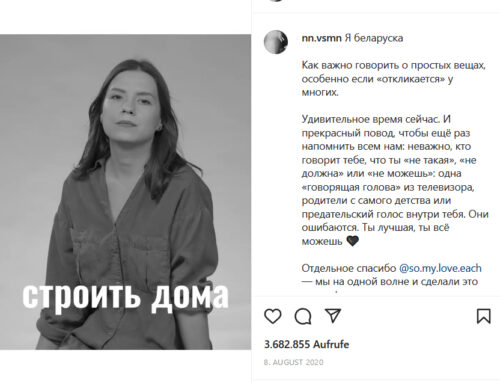“We’re alive, we’re the lucky ones” – UNICEF’s campaign for solidarity with child refugees highlights the shared stories of Harry and Ahmed, and in doing so reminds us of the millions of tragic fates during the great European trauma of the 20th century.
The campaign video “The Shared Story of Harry and Ahmed” (also known as „80 years apart, these two refugees have more in common than you’d think”), commissioned by UNICEF and produced by the advertising agency 180 Amsterdam, is an emphatic call for support for Syrian child refugees. By showing the close similarities between the stories of two refugees who left their countries as children – one fled during World War II, the other escaped the Syrian civil war –, the clip aims to highlight that the intrinsic value of every human being as well as basic human rights know no boundaries.
The video was uploaded to YouTube on February 2, 2017, by UNICEF as a contribution to the #TheChildrenOfSyria campaign and was also shared via Facebook, Twitter and the organisation’s own website. “These are the real stories of Harry and Ahmed, told in their own words,” the video description reads, emphasising the authenticity of both stories. The clip’s affective power is based on a simple realisation: although Ahmed is several decades younger than Harry, they both nonetheless share nearly the exact same fate. Here, the video’s narrative strategy makes use of a classic, albeit shortened, tension arc. The two likeable protagonists retell their story of how they fled their respective war zone, each account beginning with a desperate and painful departure on a long and uncertain journey and finally ending with a cathartic arrival in a safe, but far-away country.
Right at the beginning of the clip, Harry and Ahmed are shown in a frontal close-up, looking straight ahead at the camera – thus creating an air of intimacy enabling the viewer to empathise with the refugees’ emotionally charged stories. In an attempt to highlight the equal value of Harry and Ahmed and their individual reports, their accounts are both framed by the same dark gray background, the same ambient side-lighting, as well as seemingly identical video material from World War II and the Syrian civil war. Although it at first seems as if Harry and Ahmed recounted their experiences separately, they are, as is later revealed, sitting right next to each other all the time. As the video nears its end, it becomes increasingly clear that we are not dealing with two matching, visually identical settings for isolated interviews – in fact, the video has shown us one and the same setting from the get-go, mirroring the merging of the two initially separate stories into one shared memory.
While talking about their experiences as refugees, both Harry and Ahmed’s faces show the same emotions. These two otherwise so different narrators – one German, the other Syrian – share the same story, a story that subsequently becomes in the eyes of the viewer an affective point of emotional attachment, suddenly making the distant Syrian civil war appear almost tangible, within reach. This rhetorical strategy takes advantage of the emotional impact of World War II on Western audiences due to it being deeply rooted in family history and popular culture alike – be it the memories of one’s grandparents, stories retold by one’s parents or perhaps even experiences from way back in one’s own childhood.
World War II refugee Harry makes it easier for Western audiences to empathise and identify with the story of a refugee trying to escape a horrifying war – an affective force which is transferred and extended to Syrian refugee Ahmed as his and Harry’s stories begin to overlap and intertwine. By linking these two stories not only in terms of content but also visually, the spatial-temporal distance between the devastation in Syria and the aftermath of World War II can easily be bridged. The cultural proximity of Harry’s story makes it possible to not only feel bad for, but also feel with Ahmed. An affective interconnection between the geographically close war of the past and the geographically distant war of the present is created, thus enabling empathy.
The motif of approximation and convergence, which culminates in the final revelatory twist – Harry and Ahmed were sitting right next to each other all along –, is a recurring theme throughout the entire video. From the very beginning, the two characters are united by an increasingly similar story, told in almost the same words, separated only by an obvious language barrier. Later, they even complete each other’s (subtitled) sentences. Whereas Harry and Ahmed in the beginning remain seemingly isolated from one another in their own image frame, the content of their stories already begins overlapping – until finally converging into a shared experience, marked by the simultaneously spoken sentence: “I thought I was going to die”.
Additionally, the recordings from both World War II and the Syrian civil war used to corroborate Harry and Ahmed’s stories bear striking resemblance to one another. „I am alive, I am one of the lucky ones“, they finally say with one unified voice, signifying the video’s climax: the experiences and emotions of these two uniquely different characters, it is revealed, are practically identical. Only now, as the camera draws back and the isolated image frames merge together, does the viewer fully understand the actual setting of the interview. The happy ending to their stories, now woven into a single narrative – the safe arrival in a far-away country – is reflected here: Harry and Ahmed sit side by side, a subtle smile of relief lighting up their faces.
The motif of similarity and convergence is, however, contrasted with its very opposite: the fundamental differences between Harry and Ahmed. One is old, the other is young, one speaks German, the other Arabic, one is light-skinned, the other has dark skin, one fled from Germany, the other sought refuge in Germany – these two people, so it may seem at first glance, have hardly anything in common. This apparent contradiction is, however, dissolved by taking a look underneath the surface, with respect to their feelings, their thoughts and fears: both Harry and Ahmed share a similar fate, experienced the same hardships. The faux contradiction collapses under the affective impact and empathic weight of their shared story.
The video ends with a fade to black, coupled with the request to share the video on social media under the hashtag #RefugeesWelcome. “For every child,” the final text overlay reads, emphasising the video’s underlying message: the umbrella term „refugees“ and the collective marker „migrants“ are both superficial and cannot do the individual stories of terrified children forced to leave their country justice. Regardless of language, skin colour, religion and origin, all of these stories are, so the campaign claims, equally devastating and deserving of attention.
Donations are not explicitly requested – instead, the video aims to encourage deeper compassion for Syrian child refugees. Only the fears experienced, the hardships suffered matter, such is the message, not one’s origin or religion – the fate of any refugee is tragic, no matter where in the world and for what reason. This message is further supported by the grayscale colour palette which negates the differences in quality between the decades-old war footage and the current video material, as well as the melancholic background music.
The high interaction rate on Facebook indicates the video’s success, I.e. its high affective impact: in the first two months after its release, more than 5.1 million people had viewed the clip. Apart from a handful of critical comments, the audience’s reaction was overwhelmingly positive, as most viewers were either deeply touched (“This made me cry”) or applauded the video for its thought-provoking message (“What a powerful message”).
Finja Schmitz



